COVID-19 Hospitalizations Keep Falling in Wisconsin
Milwaukee again has second greatest per-capita outbreak.
The number of people hospitalized with COVID-19 in Wisconsin has trended downward over the past week.
There are now 308 individuals hospitalized with the disease, down from 315 yesterday and 414 on May 31st. Sunday’s total of 308 is the lowest total seen since 298 people were actively hospitalized on May 6th
That comes as the number of cases in Wisconsin keeps growing. The Department of Health Services reported that 11,329 tests were processed in the past 24 hours, with 264 positive results. The new positives bring the statewide total to 20,835.
According to data released Sunday afternoon by DHS, 2.33 percent of the tests were positive, below the seven and 14-day averages of 3.11 and 3.83 percent. As testing has expanded, particularly in the past week, the percentage of positive tests has steadily dropped.
Both the percentage positive and hospitalization rate data points don’t mean that Wisconsin has beat COVID-19, but they are positive indicators that the spread of the disease might have slowed in recent weeks.
Throughout the outbreak, 2,848 people have required hospitalization, an increase of 16 in the past day. DHS reports that 14 percent of those with a confirmed case of the disease require hospitalization.
The death toll from the disease has reached 645, with 12 deaths newly-recorded in the past 24 hours.
DHS reports that 67 percent with positive cases have recovered, as defined by a documented abatement of symptoms or a diagnosis over 30 days ago.
Milwaukee County accounts for 326 of the 647 deaths and 8,813 cases according to state data. It also again has the second greatest per-capita outbreak.
Brown County surged ahead of Milwaukee in late April and into May due to a number of facility-centric outbreaks, and was eclipsed by Racine County in recent weeks. And Racine County still has the greatest outbreak, but Brown County’s growth rate has slowed significantly and Milwaukee has again eclipsed it.
Racine County has 977.5 cases per 100,000 residents (up from 975.4). Milwaukee County has 923.6 cases per 100,000 residents (up from 910.5). Brown County, which is anchored by Green Bay, has 915 cases per 100,000 residents (up from 913.8).
Kenosha (756.8), Dodge (455.7), Rock (423.4), Walworth (422.3), Forest (365.9), Fond du Lac (227.7), Winnebago (226.6), Ozaukee (207.3), Washington (205.9) and Waukesha (202.6) are the only other counties with more than 200 cases per 100,000 residents.
The statewide average of cases per 100,000 residents rose to 360.6 (up from 356.0).
There are currently 970 ventilators and 352 intensive care unit (ICU) beds available across the state according to the Wisconsin Hospital Association. Since the data became publicly available on April 10th, WHA has reported an average of 938 ventilators and 412 ICU beds as available.
Charts and Maps
Wisconsin COVID-19 summary
| Status | Number (%) of People as of 6/7/2020 |
|---|---|
| Negative Test Results | 325,867 |
| Positive Test Results | 20,835 |
| Hospitalizations | 2,848 (14%) |
| Deaths | 647 |
Percent of COVID-19 cases by hospitalization status
| Hospitalization status | Number of confirmed cases as of 6/7/2020 | Percent of confirmed cases as of 6/7/2020 |
|---|---|---|
| Ever hospitalized | 2,848 | 14% |
| Never hospitalized | 11,675 | 56% |
| Unknown | 6,312 | 30% |
| Total | 20,835 | 100% |
Summary of COVID-19 cases by age group
| Age Group (Years) | Cases as of 6/7/2020 | Ever hospitalized as of 6/7/2020 | Any Intensive Care as of 6/7/2020 | Deaths as of 6/7/2020 |
|---|---|---|---|---|
| <10 | 610 | 16 | 1 | 0 |
| 10-19 | 1,449 | 40 | 3 | 0 |
| 20-29 | 3,795 | 141 | 20 | 6 |
| 30-39 | 3,823 | 216 | 33 | 8 |
| 40-49 | 3,454 | 338 | 78 | 19 |
| 50-59 | 3,123 | 495 | 115 | 53 |
| 60-69 | 2,226 | 610 | 176 | 105 |
| 70-79 | 1,200 | 522 | 122 | 168 |
| 80-89 | 762 | 339 | 63 | 163 |
| 90+ | 393 | 131 | 27 | 125 |
| Total | 20,835 | 2,848 | 638 | 647 |
Confirmed COVID-19 cases and deaths by gender
Confirmed COVID-19 cases and deaths by race
Confirmed COVID-19 cases and deaths by ethnicity
Number of positive cases and deaths by county
| Wisconsin County | Positive as of 6/7/2020 | Negative as of 6/7/2020 | Deaths as of 6/7/2020 | Rate (positive cases per 100,000 people) as of 6/7/2020 | Case fatality percentage (percent of cases who died) as of 6/7/2020 |
|---|---|---|---|---|---|
| Adams | 5 | 965 | 1 | 24.9 | 20% |
| Ashland | 3 | 478 | 0 | 19.1 | 0% |
| Barron | 20 | 2,481 | 0 | 44.2 | 0% |
| Bayfield | 3 | 445 | 1 | 20.0 | 33% |
| Brown | 2,377 | 20,190 | 38 | 915.0 | 2% |
| Buffalo | 6 | 749 | 2 | 45.6 | 33% |
| Burnett | 1 | 537 | 1 | 6.6 | 100% |
| Calumet | 80 | 2,178 | 1 | 160.6 | 1% |
| Chippewa | 59 | 3,339 | 0 | 92.7 | 0% |
| Clark | 42 | 1,465 | 4 | 121.8 | 10% |
| Columbia | 46 | 3,030 | 1 | 80.8 | 2% |
| Crawford | 26 | 1,149 | 0 | 159.6 | 0% |
| Dane | 843 | 37,809 | 29 | 159.1 | 3% |
| Dodge | 400 | 6,269 | 4 | 455.7 | 1% |
| Door | 39 | 1,880 | 3 | 142.1 | 8% |
| Douglas | 20 | 1,620 | 0 | 46.1 | 0% |
| Dunn | 27 | 2,615 | 0 | 60.7 | 0% |
| Eau Claire | 123 | 5,907 | 0 | 119.4 | 0% |
| Florence | 2 | 266 | 0 | 46.1 | 0% |
| Fond du Lac | 233 | 6,190 | 6 | 227.7 | 3% |
| Forest | 33 | 371 | 2 | 365.9 | 6% |
| Grant | 98 | 3,261 | 12 | 189.1 | 12% |
| Green | 71 | 1,867 | 0 | 192.6 | 0% |
| Green Lake | 22 | 1,051 | 0 | 117.3 | 0% |
| Iowa | 17 | 1,353 | 0 | 72.0 | 0% |
| Iron | 2 | 270 | 1 | 35.0 | 50% |
| Jackson | 19 | 1,467 | 1 | 92.7 | 5% |
| Jefferson | 128 | 4,110 | 3 | 151.2 | 2% |
| Juneau | 23 | 1,213 | 1 | 87.1 | 4% |
| Kenosha | 1,274 | 10,291 | 34 | 756.8 | 3% |
| Kewaunee | 36 | 970 | 1 | 176.8 | 3% |
| La Crosse | 69 | 6,868 | 0 | 58.5 | 0% |
| Lafayette | 33 | 810 | 0 | 197.2 | 0% |
| Langlade | 4 | 856 | 0 | 20.9 | 0% |
| Lincoln | 7 | 1,005 | 0 | 25.1 | 0% |
| Manitowoc | 39 | 3,670 | 1 | 49.1 | 3% |
| Marathon | 64 | 3,918 | 1 | 47.3 | 2% |
| Marinette | 36 | 3,203 | 3 | 88.8 | 8% |
| Marquette | 5 | 702 | 1 | 32.9 | 20% |
| Menominee | 3 | 880 | 0 | 65.5 | 0% |
| Milwaukee | 8,813 | 60,377 | 326 | 923.6 | 4% |
| Monroe | 19 | 3,132 | 1 | 41.8 | 5% |
| Oconto | 42 | 2,150 | 0 | 111.8 | 0% |
| Oneida | 12 | 1,493 | 0 | 34.0 | 0% |
| Outagamie | 270 | 10,425 | 8 | 146.1 | 3% |
| Ozaukee | 183 | 4,252 | 13 | 207.3 | 7% |
| Pepin | 1 | 428 | 0 | 13.8 | 0% |
| Pierce | 50 | 1,801 | 0 | 120.2 | 0% |
| Polk | 33 | 2,063 | 1 | 76.1 | 3% |
| Portage | 35 | 2,197 | 0 | 49.6 | 0% |
| Price | 2 | 620 | 0 | 14.8 | 0% |
| Racine | 1,910 | 15,475 | 47 | 977.5 | 2% |
| Richland | 14 | 1,112 | 4 | 79.8 | 29% |
| Rock | 685 | 10,410 | 21 | 423.4 | 3% |
| Rusk | 5 | 420 | 0 | 35.3 | 0% |
| Sauk | 83 | 4,286 | 3 | 130.5 | 4% |
| Sawyer | 8 | 1,307 | 0 | 48.9 | 0% |
| Shawano | 56 | 2,355 | 0 | 136.6 | 0% |
| Sheboygan | 114 | 4,523 | 3 | 99.0 | 3% |
| St. Croix | 105 | 3,790 | 0 | 119.4 | 0% |
| Taylor | 2 | 573 | 0 | 9.8 | 0% |
| Trempealeau | 40 | 2,411 | 0 | 135.9 | 0% |
| Vernon | 21 | 1,640 | 0 | 68.8 | 0% |
| Vilas | 8 | 597 | 0 | 37.0 | 0% |
| Walworth | 435 | 5,568 | 17 | 422.3 | 4% |
| Washburn | 3 | 700 | 0 | 19.1 | 0% |
| Washington | 277 | 5,929 | 9 | 205.9 | 3% |
| Waukesha | 808 | 12,002 | 33 | 202.6 | 4% |
| Waupaca | 57 | 3,452 | 1 | 110.8 | 2% |
| Waushara | 10 | 1,585 | 0 | 41.5 | 0% |
| Winnebago | 385 | 8,512 | 7 | 226.6 | 2% |
| Wood | 11 | 2,584 | 1 | 15.0 | 9% |
| Total | 20,835 | 325,867 | 647 | 360.6 | 3% |
If you think stories like this are important, become a member of Urban Milwaukee and help support real, independent journalism. Plus you get some cool added benefits.
More about the Coronavirus Pandemic
- Governors Tony Evers, JB Pritzker, Tim Walz, and Gretchen Whitmer Issue a Joint Statement Concerning Reports that Donald Trump Gave Russian Dictator Putin American COVID-19 Supplies - Gov. Tony Evers - Oct 11th, 2024
- MHD Release: Milwaukee Health Department Launches COVID-19 Wastewater Testing Dashboard - City of Milwaukee Health Department - Jan 23rd, 2024
- Milwaukee County Announces New Policies Related to COVID-19 Pandemic - David Crowley - May 9th, 2023
- DHS Details End of Emergency COVID-19 Response - Wisconsin Department of Health Services - Apr 26th, 2023
- Milwaukee Health Department Announces Upcoming Changes to COVID-19 Services - City of Milwaukee Health Department - Mar 17th, 2023
- Fitzgerald Applauds Passage of COVID-19 Origin Act - U.S. Rep. Scott Fitzgerald - Mar 10th, 2023
- DHS Expands Free COVID-19 Testing Program - Wisconsin Department of Health Services - Feb 10th, 2023
- MKE County: COVID-19 Hospitalizations Rising - Graham Kilmer - Jan 16th, 2023
- Not Enough Getting Bivalent Booster Shots, State Health Officials Warn - Gaby Vinick - Dec 26th, 2022
- Nearly All Wisconsinites Age 6 Months and Older Now Eligible for Updated COVID-19 Vaccine - Wisconsin Department of Health Services - Dec 15th, 2022
Read more about Coronavirus Pandemic here



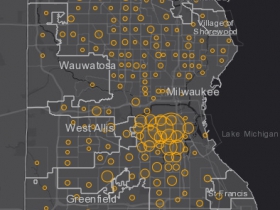
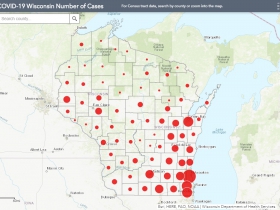
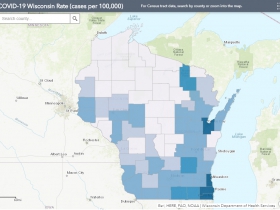
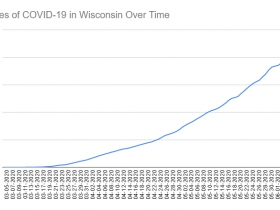
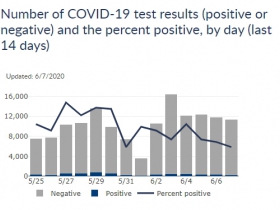

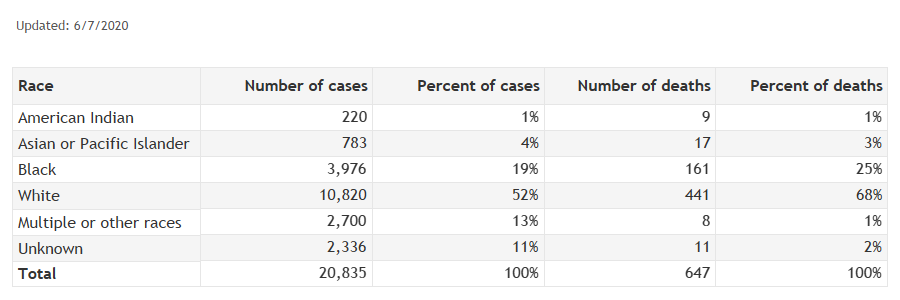



















Good morning Jeramey This has been bugging me for at least 2 weeks now and I finally figured it out. Every day we know the zip code for each of the new folks who have tested positive. We know that some will be contagious for a day or two and others might be contagious for a week or more. So on any given day it can be said that x number of folks tested positive in this zip code on this day and that they will be positive for (estimate least / Max number of days) in the future This obviously is additive to the previous days and so people have greater sense “where” the virus is. In a day gone by, large quarantine signs were put on the doors of the homes of those infected with some contagious disease and no big deal was made of “privacy”.
What is also clear is that folks still do not get it. Because there is no emphasis (in Wisconsin the Hospital Association does do this) the number of beds that are available and the length of time a bed can be “in use” This article on a national scale for each state would be very helpful to people. Then the question is when there are no more beds who gets them, folks who wore mask and still got sick or those that did no wear mask and got sick? That would be an interesting story Yes rubbing salt in the wound but if it takes that to get folks to know and act as if it is real then maybe a little salt will help.
The other story and maybe this has been written is how in 10 million people at different spread rates are infected. Now if we did not have a hospitalized death rate of about 20+% there is no issue. Then to explain how many folks can be taken care of with the very limited hospital bed etc that we have To emphasis the INTENSE care that it takes to take care of all those who become seriously ill and then what % of then die.
Morning Thought Thanks for all that you are doing Bummer about the fire!!
Peace